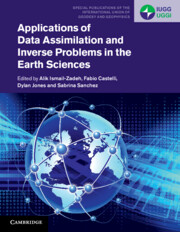Refine search
Actions for selected content:
6993 results in Mathematical modeling and methods
16 - Joint and Constrained Inversion as Hypothesis Testing Tools
- from Part III - ‘Solid’ Earth Applications: From the Surface to the Core
-
-
- Book:
- Applications of Data Assimilation and Inverse Problems in the Earth Sciences
- Published online:
- 20 June 2023
- Print publication:
- 06 July 2023, pp 252-264
-
- Chapter
- Export citation
Part II - ‘Fluid’ Earth Applications: From the Surface to the Space
-
- Book:
- Applications of Data Assimilation and Inverse Problems in the Earth Sciences
- Published online:
- 20 June 2023
- Print publication:
- 06 July 2023, pp 77-172
-
- Chapter
- Export citation
21 - Understanding and Predicting Geomagnetic Secular Variation via Data Assimilation
- from Part III - ‘Solid’ Earth Applications: From the Surface to the Core
-
-
- Book:
- Applications of Data Assimilation and Inverse Problems in the Earth Sciences
- Published online:
- 20 June 2023
- Print publication:
- 06 July 2023, pp 326-340
-
- Chapter
- Export citation
5 - Data Assimilation of Seasonal Snow
- from Part II - ‘Fluid’ Earth Applications: From the Surface to the Space
-
-
- Book:
- Applications of Data Assimilation and Inverse Problems in the Earth Sciences
- Published online:
- 20 June 2023
- Print publication:
- 06 July 2023, pp 79-92
-
- Chapter
- Export citation
Index
-
- Book:
- Applications of Data Assimilation and Inverse Problems in the Earth Sciences
- Published online:
- 20 June 2023
- Print publication:
- 06 July 2023, pp 356-358
-
- Chapter
- Export citation
Copyright page
-
- Book:
- Applications of Data Assimilation and Inverse Problems in the Earth Sciences
- Published online:
- 20 June 2023
- Print publication:
- 06 July 2023, pp iv-iv
-
- Chapter
- Export citation
Contents
-
- Book:
- Applications of Data Assimilation and Inverse Problems in the Earth Sciences
- Published online:
- 20 June 2023
- Print publication:
- 06 July 2023, pp v-vi
-
- Chapter
- Export citation
22 - Pointwise and Spectral Observations in Geomagnetic Data Assimilation: The Importance of Localization
- from Part III - ‘Solid’ Earth Applications: From the Surface to the Core
-
-
- Book:
- Applications of Data Assimilation and Inverse Problems in the Earth Sciences
- Published online:
- 20 June 2023
- Print publication:
- 06 July 2023, pp 341-355
-
- Chapter
- Export citation
9 - Data Assimilation of Volcanic Clouds: Recent Advances and Implications on Operational Forecasts
- from Part II - ‘Fluid’ Earth Applications: From the Surface to the Space
-
-
- Book:
- Applications of Data Assimilation and Inverse Problems in the Earth Sciences
- Published online:
- 20 June 2023
- Print publication:
- 06 July 2023, pp 144-156
-
- Chapter
- Export citation
12 - Inverse Problems in Lava Dynamics
- from Part III - ‘Solid’ Earth Applications: From the Surface to the Core
-
-
- Book:
- Applications of Data Assimilation and Inverse Problems in the Earth Sciences
- Published online:
- 20 June 2023
- Print publication:
- 06 July 2023, pp 196-208
-
- Chapter
- Export citation
7.6 - Appendix: Multivariate 1D-VAR Assimilation with an Adjoint
- from 7 - Data Assimilation in Hydrological Sciences
-
- Book:
- Applications of Data Assimilation and Inverse Problems in the Earth Sciences
- Published online:
- 20 June 2023
- Print publication:
- 06 July 2023, pp 124-130
-
- Chapter
- Export citation
Preface
-
- Book:
- Applications of Data Assimilation and Inverse Problems in the Earth Sciences
- Published online:
- 20 June 2023
- Print publication:
- 06 July 2023, pp ix-ix
-
- Chapter
- Export citation
MODELLING MICROWAVES IN BAUXITE
- Part of
-
- Journal:
- The ANZIAM Journal / Volume 65 / Issue 1-2 / January 2023
- Published online by Cambridge University Press:
- 04 July 2023, pp. 111-134
-
- Article
-
- You have access
- Open access
- HTML
- Export citation
ON THE SAFE STORAGE OF BAGASSE
- Part of
-
- Journal:
- The ANZIAM Journal / Volume 65 / Issue 1-2 / January 2023
- Published online by Cambridge University Press:
- 23 June 2023, pp. 79-92
-
- Article
- Export citation

Applications of Data Assimilation and Inverse Problems in the Earth Sciences
-
- Published online:
- 20 June 2023
- Print publication:
- 06 July 2023
COUETTE FLOW OVER A HEAT ISLAND
- Part of
-
- Journal:
- The ANZIAM Journal / Volume 65 / Issue 1-2 / January 2023
- Published online by Cambridge University Press:
- 05 June 2023, pp. 3-28
-
- Article
-
- You have access
- Open access
- HTML
- Export citation
3 - Fechnerian Scaling: Dissimilarity Cumulation Theory
-
-
- Book:
- New Handbook of Mathematical Psychology
- Published online:
- 20 April 2023
- Print publication:
- 27 April 2023, pp 80-162
-
- Chapter
- Export citation
Preface
-
- Book:
- New Handbook of Mathematical Psychology
- Published online:
- 20 April 2023
- Print publication:
- 27 April 2023, pp vii-xvi
-
- Chapter
- Export citation
10 - Encoding Models in Neuroimaging
-
-
- Book:
- New Handbook of Mathematical Psychology
- Published online:
- 20 April 2023
- Print publication:
- 27 April 2023, pp 421-472
-
- Chapter
- Export citation
8 - Approximate Bayesian Computation
-
-
- Book:
- New Handbook of Mathematical Psychology
- Published online:
- 20 April 2023
- Print publication:
- 27 April 2023, pp 357-384
-
- Chapter
- Export citation




